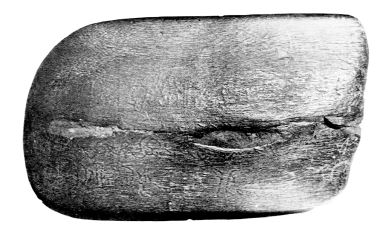
Rongorongo text Z
Encyclopedia

Rongorongo
Rongorongo is a system of glyphs discovered in the 19th century on Easter Island that appears to be writing or proto-writing. It cannot be read despite numerous attempts at decipherment. Although some calendrical and what might prove to be genealogical information has been identified, not even...
corpus, also known as Poike, may be one of two dozen surviving rongorongo texts.
Other names
Z is the standard designation, continuing from BarthelThomas Barthel
Thomas Sylvester Barthel was a German ethnologist and epigrapher who is best known for cataloguing the undeciphered rongorongo script of Easter Island....
(1958). Fischer (1997) numbers it among the imitative pieces made for tourists as T4.
Location
Museo Nacional de Historia Natural, Santiago. Catalog # 12060.Physical description
A small light-weight piece, 10.7 × 5.8 × 2.7 cm, of unknown wood and darkened with age. One end has been beveled to a sharp edge, the other, broken off and smoothed. Side a is badly cracked. It is the smallest intact piece.Provenance
In 1937 José Paté discovered this tablet by the foundations of the ruins of a stone house near ahu Mahatua, the home village of Metoro Tau‘a Ure, Bishop Jaussen'sFlorentin-Étienne Jaussen
Monsignor Florentin-Étienne Jaussen was the first bishop of Tahiti and the man who brought the rongorongo script of Easter Island to the world's attention. In the 1860s Bishop Jaussen was responsible for ending the slave raids on Easter Island.Jaussen was born in Rocles, France...
informant, at the base of Poike
Poike
Poike is one of three main extinct volcanoes that form Rapa Nui . At 370 metres, it is the island's second highest peak after Terevaka.right|275 px|thumb|[[Ahu Tongariki]] with Poike in the background...
Volcano, near the cave Aka o Keke that contains a few crude rongorongo-type petroglyphs. Paté gave the tablet to Father Sebastian, who then donated it to the Santiago museum in 1938.
The authenticity of the piece is immediately suspect because it is not boustrophedon
Boustrophedon
Boustrophedon , is a type of bi-directional text, mostly seen in ancient manuscripts and other inscriptions. Every other line of writing is flipped or reversed, with reversed letters. Rather than going left-to-right as in modern English, or right-to-left as in Arabic and Hebrew, alternate lines in...
, typical of early forgeries. However, Fischer (1997) suspects that it may be a palimpsest
Palimpsest
A palimpsest is a manuscript page from a scroll or book from which the text has been scraped off and which can be used again. The word "palimpsest" comes through Latin palimpsēstus from Ancient Greek παλίμψηστος originally compounded from πάλιν and ψάω literally meaning “scraped...
, that someone had carved an imitative inscription over an authentic but by then illegible text, and that it was somehow forgotten rather than sold. It may have also been an attempt to revive rongorongo for personal reasons.
Text
Fischer (1997) reports that in strong light four lines of imitative (crude, non-boustrophedon) script are visible on both sides, but that "in indirect light there are fainter traces of smaller rongorongo glyphs in six or seven lines on each side." The smaller hand implies a second scribe. Even the cruder glyphs are only partially legible, with some 55 "trace elements" remaining..jpg)
Barthel did not transcribe this text.
Fischer
Fischer does not believe the legible text to be genuine, and was unable to transcribe the underlying text.

